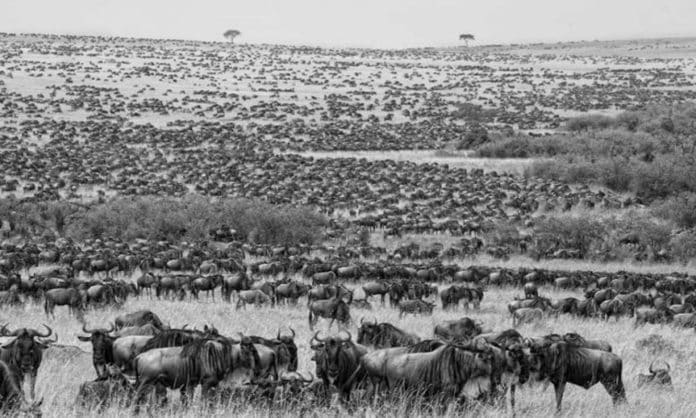Unlocking the Secrets of the Great Migration: Exploring Tanzania’s Iconic Wildlife Route on a Map
The Great Migration is a remarkable natural phenomenon that takes place in Tanzania. It is one of the most awe-inspiring events in the animal kingdom, attracting nature enthusiasts and wildlife photographers from around the world. This article will guide you through the secrets of the Great Migration and show you how to explore Tanzania’s iconic wildlife route using a map.
Understanding the significance of the Great Migration
The Great Migration is the annual movement of millions of wildebeest, zebras, and other herbivores across the vast plains of Tanzania. It is an extraordinary spectacle that showcases the resilience and adaptability of wildlife in the face of challenges such as drought and predators. The migration is driven by the search for fresh grazing lands and water sources. This epic journey covers a distance of over 1,800 miles, making it one of the longest and largest land migrations in the world.
The route of the Great Migration in Tanzania

The Great Migration in Tanzania follows a circular route that spans across different national parks and conservation areas. The journey begins in the southern Serengeti, where the wildebeest give birth to their young during the calving season. As the dry season progresses, the herds start moving northwards, crossing the Grumeti River and making their way into the central Serengeti. From there, they continue their journey towards the northern Serengeti and cross the Mara River, which marks the border between Tanzania and Kenya.
Exploring the iconic Serengeti National Park
Serengeti National Park is the crown jewel of Tanzania’s wildlife reserves and plays a crucial role in the Great Migration. This vast expanse of grassland and savannah is home to an incredible diversity of wildlife, including the iconic Big Five – lions, elephants, buffalos, leopards, and rhinos. Exploring the Serengeti on a map allows you to identify the best locations for wildlife sightings and plan your safari accordingly. The park offers various accommodation options, from luxury lodges to mobile campsites, ensuring a memorable and comfortable experience.
Witnessing the wildebeest river crossings
One of the most thrilling moments of the Great Migration is the wildebeest river crossings. These crossings occur when the herds encounter rivers, such as the Grumeti and Mara, that lie in their path. Thousands of wildebeest gather on the riverbanks, hesitating before taking the plunge into the treacherous waters infested with crocodiles. Witnessing this dramatic event is a once-in-a-lifetime experience and can be strategically planned by using a map to locate the best vantage points along the rivers.
The best time to see the Great Migration
To maximize your chances of witnessing the Great Migration in all its glory, it is essential to plan your trip during the right time of the year. The timing of the migration is influenced by rainfall patterns and the availability of grazing lands. The herds typically arrive in the southern Serengeti in December and stay until March, during the calving season. From April to June, they start moving towards the central Serengeti, and by July, they reach the northern Serengeti and the Mara River. Late August to September is the peak time for river crossings, offering prime opportunities for wildlife enthusiasts.
Tips for planning your Great Migration safari
When planning your Great Migration safari, there are a few key tips to keep in mind. Firstly, book your accommodations well in advance, as they tend to fill up quickly during the peak migration season. Secondly, consider hiring a knowledgeable guide who can navigate the complex network of roads and tracks in the national parks. They can also provide valuable insights into the behavior of the wildlife and help you make the most of your safari experience. Lastly, pack appropriate clothing and gear, including binoculars, a camera with a telephoto lens, and comfortable walking shoes, to ensure you are well-prepared for the adventure ahead.
Using a map to navigate the Great Migration route
A map is an invaluable tool for navigating the Great Migration route in Tanzania. It allows you to visualize the entire migration path, understand the geographical features of the area, and identify the best locations for wildlife sightings. There are various types of maps available, including physical maps that show the topography of the land, and digital maps that can be accessed on smartphones or GPS devices. By studying the map, you can plan your itinerary, choose the most strategic vantage points, and track the movement of the herds in real-time.
Other wildlife attractions along the Great Migration route

While the Great Migration steals the spotlight, Tanzania’s wildlife route offers many other attractions worth exploring. Along the migration path, you can encounter a diverse range of wildlife, including giraffes, cheetahs, hyenas, and a plethora of bird species. Additionally, the Ngorongoro Crater, located near the southern Serengeti, is a unique ecosystem teeming with wildlife and offers stunning views of the surrounding landscapes. By venturing off the beaten path and exploring the surrounding areas, you can truly capture the essence of Tanzania’s wildlife and make your safari experience unforgettable.
Capturing the essence of the Great Migration on a map
Exploring the Great Migration in Tanzania is an adventure like no other. By understanding the significance of this natural phenomenon and using a map to navigate the route, you can witness the awe-inspiring sight of millions of animals on the move. From the iconic Serengeti National Park to the thrilling wildebeest river crossings, every moment of the journey is a testament to the power and resilience of nature. So, pack your bags, grab your map, and embark on a safari that will leave you with memories to last a lifetime.
For more articles related to Wildlife Parks in Tanzania click here!

































